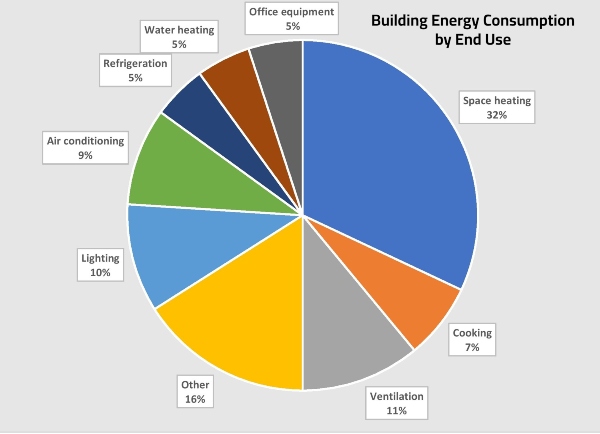Are you looking to create a long-term energy management plan but don't know where to start? Having a better understanding of where your energy dollars are going can help you make more informed decisions about how to make better use of those energy dollars.
Breaking down building energy use
Space heating is the largest energy user in most commercial buildings, according to U.S. Energy Information Administration data released in 2022, accounting for about 32% of total energy consumption for the average building. Ventilation is second biggest energy user at 11%, with lighting coming in third at 10%. The chart below provides a breakdown by various end uses.
These are averages across a variety of building types. Individual facilities and building types may have different energy use patterns.
Simple energy-saving measures
While every building is different, these simple measures will reduce your energy costs and improve the comfort and productivity of your facility.
- HVAC maintenance. Hire a qualified professional to inspect and clean your heating and cooling systems at least once per year. Change air filters regularly according to manufacturer's instructions.
- Adjust temperatures. Use building automation controls to adjust building temperatures to optimize savings and comfort based on your operating schedule.
- Control lighting. Install occupancy or vacancy sensors in areas with varying occupancy – such as restrooms and meeting rooms – to ensure that lights are running only when needed. Use automation controls to turn lights on and off based on building occupancy or operating schedules.
- Seal your building envelope. Regularly check for gaps or air leaks in windows and exterior doors and seal any you find with caulk or weatherstripping. Hire a qualified contractor to ensure that your building is insulated according to relevant building energy codes, such as ASHRAE 90.1. Add insulation if needed to improve comfort and save energy.
Developing an energy management plan
Long-term savings requires a plan. Here are five key steps to developing and implementing a successful energy management plan.
- Make a commitment. Get the full support of the business owner or top management and include measurable goals and objectives, as well as a method to track progress.
- Assess performance. Use ENERGY STAR Portfolio Manager®, a free tool available from the U.S. Environmental Protection Agency (EPA), to benchmark your energy performance and establish a baseline to track your progress.
- Implement your plan. With goals in place, develop a detailed action plan for reducing waste and improving overall energy efficiency. A facility energy audit can help you target the most effective cost-saving opportunities.
- Evaluate progress. Compare energy use data and action plan measures to your performance goals. Use the results to create new action plans, identify best practices and set new performance goals.
- Recognize achievements. Publicizing your energy-saving and sustainability achievements will help build momentum for additional projects and improve the public image of your organization.
For more information, see Guidelines for Energy Management from the EPA.



